Behavioral Theory and Nursing Education
VerifiedAdded on 2020/02/24
|9
|2799
|41
AI Summary
The assignment examines the application of behavioral theory in nursing education. It emphasizes the theory's influence on guiding students, teaching methodologies, and evaluating their clinical skills within a structured learning environment. The document highlights the passive role of students as recipients of information and the significant impact of the clinical setting in shaping their learning.
Contribute Materials
Your contribution can guide someone’s learning journey. Share your
documents today.
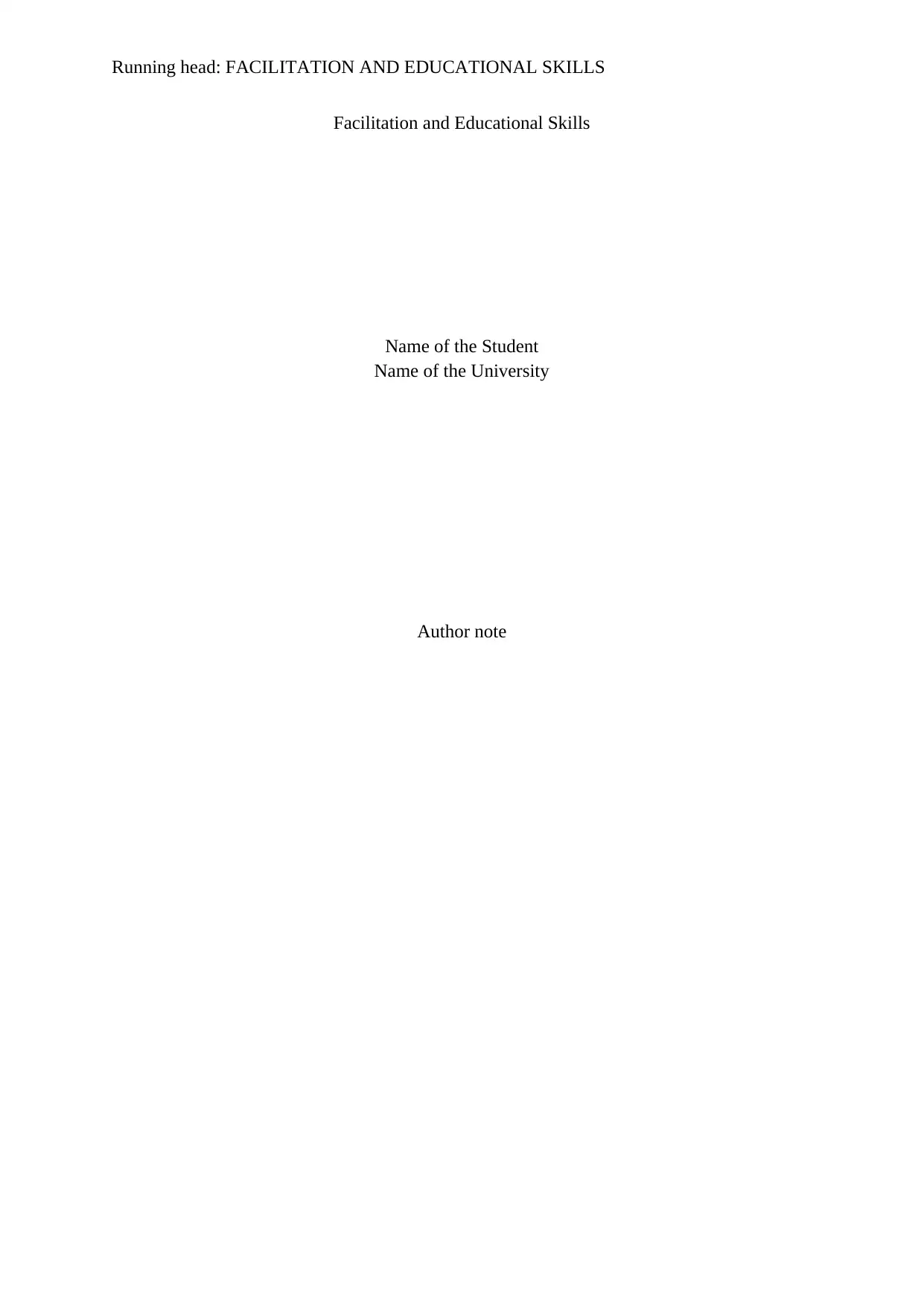
Running head: FACILITATION AND EDUCATIONAL SKILLS
Facilitation and Educational Skills
Name of the Student
Name of the University
Author note
Facilitation and Educational Skills
Name of the Student
Name of the University
Author note
Secure Best Marks with AI Grader
Need help grading? Try our AI Grader for instant feedback on your assignments.
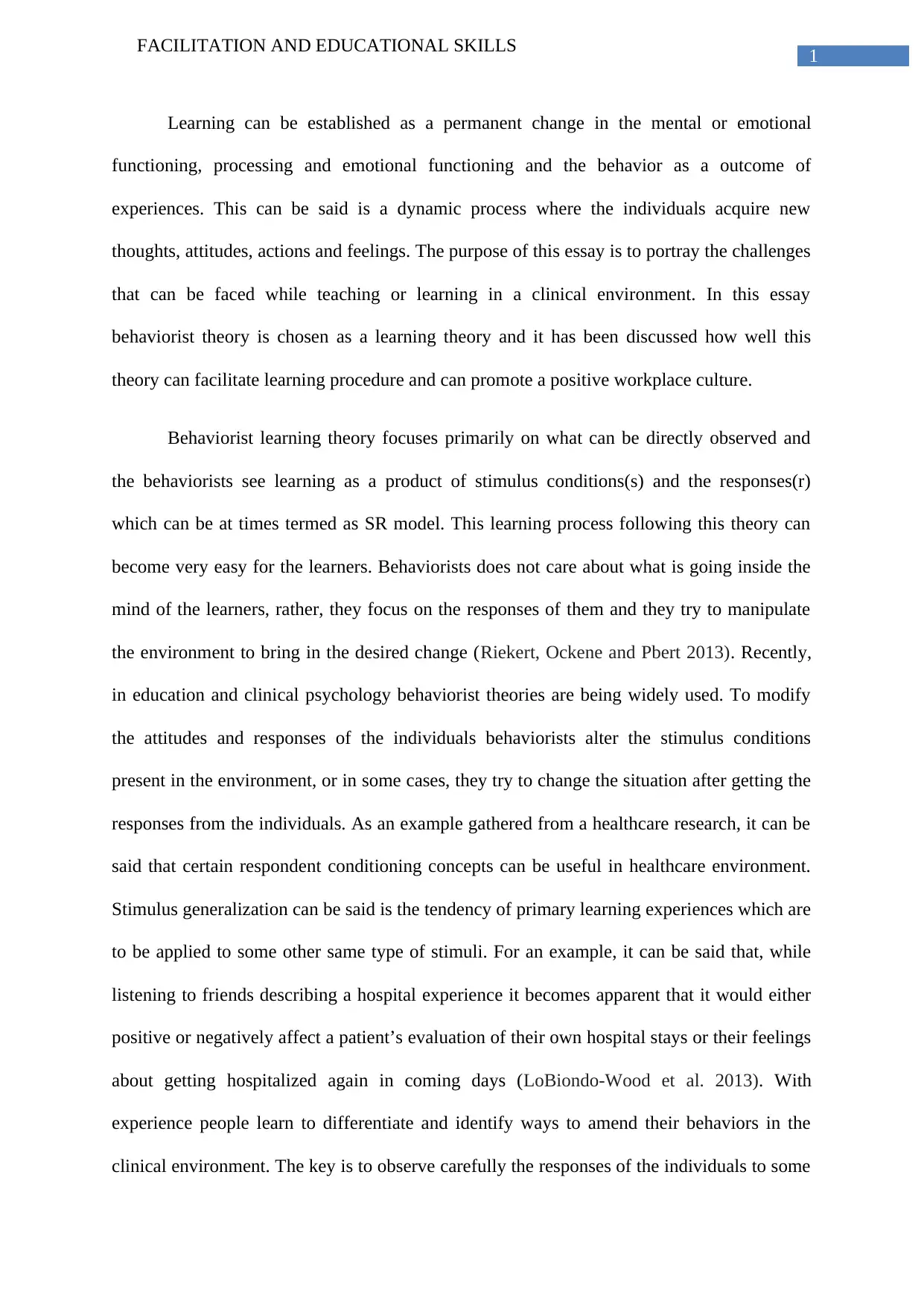
1
FACILITATION AND EDUCATIONAL SKILLS
Learning can be established as a permanent change in the mental or emotional
functioning, processing and emotional functioning and the behavior as a outcome of
experiences. This can be said is a dynamic process where the individuals acquire new
thoughts, attitudes, actions and feelings. The purpose of this essay is to portray the challenges
that can be faced while teaching or learning in a clinical environment. In this essay
behaviorist theory is chosen as a learning theory and it has been discussed how well this
theory can facilitate learning procedure and can promote a positive workplace culture.
Behaviorist learning theory focuses primarily on what can be directly observed and
the behaviorists see learning as a product of stimulus conditions(s) and the responses(r)
which can be at times termed as SR model. This learning process following this theory can
become very easy for the learners. Behaviorists does not care about what is going inside the
mind of the learners, rather, they focus on the responses of them and they try to manipulate
the environment to bring in the desired change (Riekert, Ockene and Pbert 2013). Recently,
in education and clinical psychology behaviorist theories are being widely used. To modify
the attitudes and responses of the individuals behaviorists alter the stimulus conditions
present in the environment, or in some cases, they try to change the situation after getting the
responses from the individuals. As an example gathered from a healthcare research, it can be
said that certain respondent conditioning concepts can be useful in healthcare environment.
Stimulus generalization can be said is the tendency of primary learning experiences which are
to be applied to some other same type of stimuli. For an example, it can be said that, while
listening to friends describing a hospital experience it becomes apparent that it would either
positive or negatively affect a patient’s evaluation of their own hospital stays or their feelings
about getting hospitalized again in coming days (LoBiondo-Wood et al. 2013). With
experience people learn to differentiate and identify ways to amend their behaviors in the
clinical environment. The key is to observe carefully the responses of the individuals to some
FACILITATION AND EDUCATIONAL SKILLS
Learning can be established as a permanent change in the mental or emotional
functioning, processing and emotional functioning and the behavior as a outcome of
experiences. This can be said is a dynamic process where the individuals acquire new
thoughts, attitudes, actions and feelings. The purpose of this essay is to portray the challenges
that can be faced while teaching or learning in a clinical environment. In this essay
behaviorist theory is chosen as a learning theory and it has been discussed how well this
theory can facilitate learning procedure and can promote a positive workplace culture.
Behaviorist learning theory focuses primarily on what can be directly observed and
the behaviorists see learning as a product of stimulus conditions(s) and the responses(r)
which can be at times termed as SR model. This learning process following this theory can
become very easy for the learners. Behaviorists does not care about what is going inside the
mind of the learners, rather, they focus on the responses of them and they try to manipulate
the environment to bring in the desired change (Riekert, Ockene and Pbert 2013). Recently,
in education and clinical psychology behaviorist theories are being widely used. To modify
the attitudes and responses of the individuals behaviorists alter the stimulus conditions
present in the environment, or in some cases, they try to change the situation after getting the
responses from the individuals. As an example gathered from a healthcare research, it can be
said that certain respondent conditioning concepts can be useful in healthcare environment.
Stimulus generalization can be said is the tendency of primary learning experiences which are
to be applied to some other same type of stimuli. For an example, it can be said that, while
listening to friends describing a hospital experience it becomes apparent that it would either
positive or negatively affect a patient’s evaluation of their own hospital stays or their feelings
about getting hospitalized again in coming days (LoBiondo-Wood et al. 2013). With
experience people learn to differentiate and identify ways to amend their behaviors in the
clinical environment. The key is to observe carefully the responses of the individuals to some
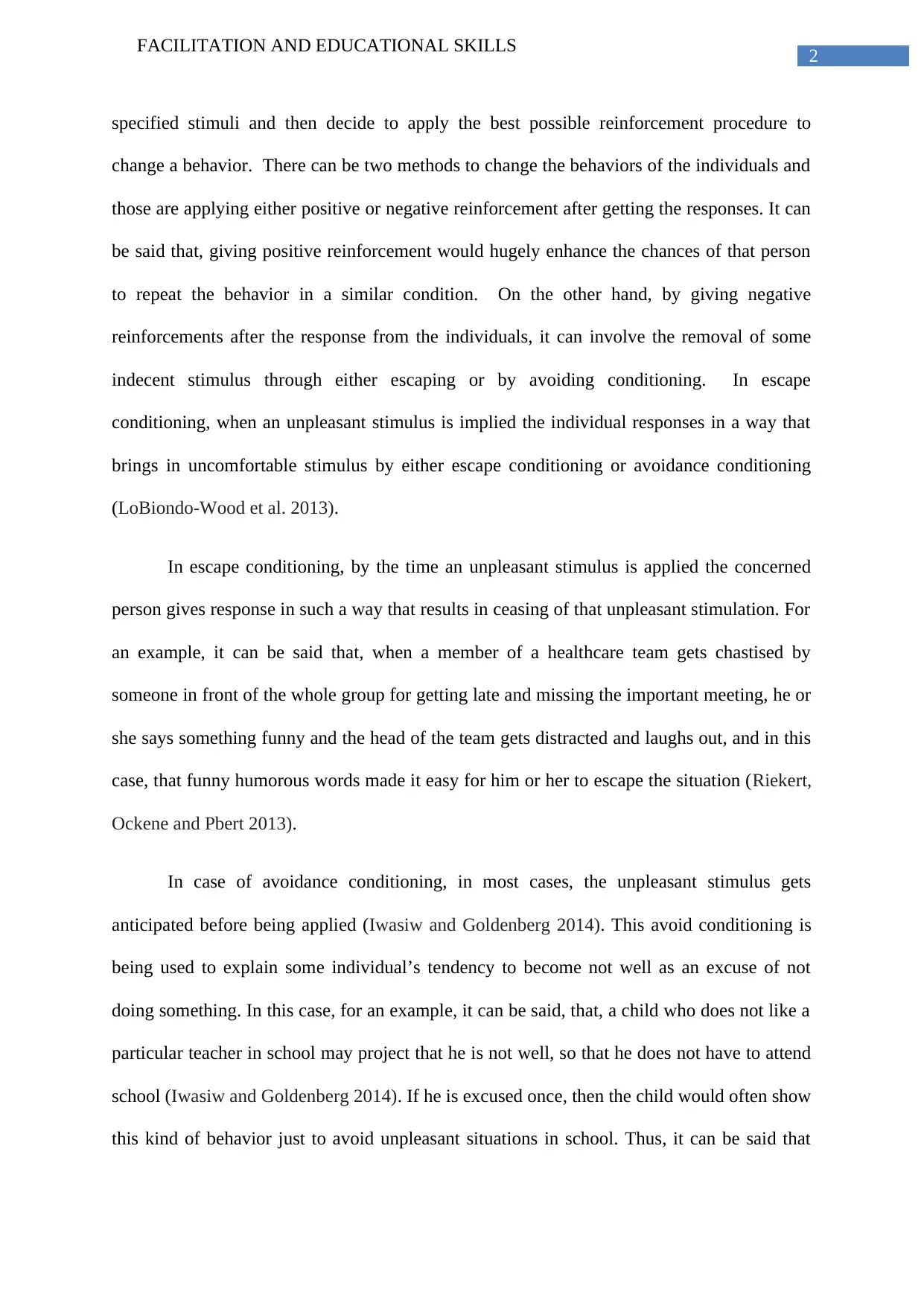
2
FACILITATION AND EDUCATIONAL SKILLS
specified stimuli and then decide to apply the best possible reinforcement procedure to
change a behavior. There can be two methods to change the behaviors of the individuals and
those are applying either positive or negative reinforcement after getting the responses. It can
be said that, giving positive reinforcement would hugely enhance the chances of that person
to repeat the behavior in a similar condition. On the other hand, by giving negative
reinforcements after the response from the individuals, it can involve the removal of some
indecent stimulus through either escaping or by avoiding conditioning. In escape
conditioning, when an unpleasant stimulus is implied the individual responses in a way that
brings in uncomfortable stimulus by either escape conditioning or avoidance conditioning
(LoBiondo-Wood et al. 2013).
In escape conditioning, by the time an unpleasant stimulus is applied the concerned
person gives response in such a way that results in ceasing of that unpleasant stimulation. For
an example, it can be said that, when a member of a healthcare team gets chastised by
someone in front of the whole group for getting late and missing the important meeting, he or
she says something funny and the head of the team gets distracted and laughs out, and in this
case, that funny humorous words made it easy for him or her to escape the situation (Riekert,
Ockene and Pbert 2013).
In case of avoidance conditioning, in most cases, the unpleasant stimulus gets
anticipated before being applied (Iwasiw and Goldenberg 2014). This avoid conditioning is
being used to explain some individual’s tendency to become not well as an excuse of not
doing something. In this case, for an example, it can be said, that, a child who does not like a
particular teacher in school may project that he is not well, so that he does not have to attend
school (Iwasiw and Goldenberg 2014). If he is excused once, then the child would often show
this kind of behavior just to avoid unpleasant situations in school. Thus, it can be said that
FACILITATION AND EDUCATIONAL SKILLS
specified stimuli and then decide to apply the best possible reinforcement procedure to
change a behavior. There can be two methods to change the behaviors of the individuals and
those are applying either positive or negative reinforcement after getting the responses. It can
be said that, giving positive reinforcement would hugely enhance the chances of that person
to repeat the behavior in a similar condition. On the other hand, by giving negative
reinforcements after the response from the individuals, it can involve the removal of some
indecent stimulus through either escaping or by avoiding conditioning. In escape
conditioning, when an unpleasant stimulus is implied the individual responses in a way that
brings in uncomfortable stimulus by either escape conditioning or avoidance conditioning
(LoBiondo-Wood et al. 2013).
In escape conditioning, by the time an unpleasant stimulus is applied the concerned
person gives response in such a way that results in ceasing of that unpleasant stimulation. For
an example, it can be said that, when a member of a healthcare team gets chastised by
someone in front of the whole group for getting late and missing the important meeting, he or
she says something funny and the head of the team gets distracted and laughs out, and in this
case, that funny humorous words made it easy for him or her to escape the situation (Riekert,
Ockene and Pbert 2013).
In case of avoidance conditioning, in most cases, the unpleasant stimulus gets
anticipated before being applied (Iwasiw and Goldenberg 2014). This avoid conditioning is
being used to explain some individual’s tendency to become not well as an excuse of not
doing something. In this case, for an example, it can be said, that, a child who does not like a
particular teacher in school may project that he is not well, so that he does not have to attend
school (Iwasiw and Goldenberg 2014). If he is excused once, then the child would often show
this kind of behavior just to avoid unpleasant situations in school. Thus, it can be said that
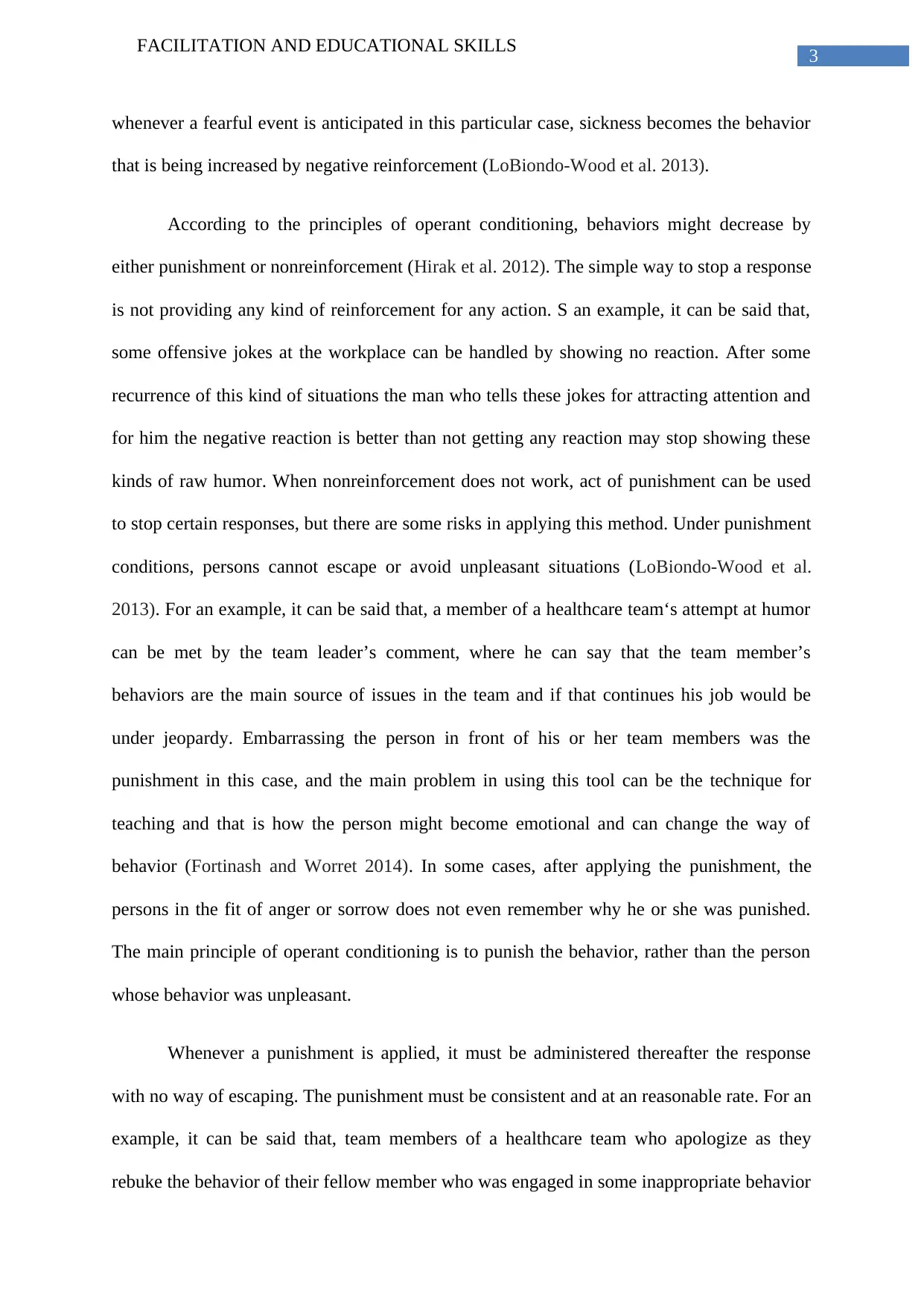
3
FACILITATION AND EDUCATIONAL SKILLS
whenever a fearful event is anticipated in this particular case, sickness becomes the behavior
that is being increased by negative reinforcement (LoBiondo-Wood et al. 2013).
According to the principles of operant conditioning, behaviors might decrease by
either punishment or nonreinforcement (Hirak et al. 2012). The simple way to stop a response
is not providing any kind of reinforcement for any action. S an example, it can be said that,
some offensive jokes at the workplace can be handled by showing no reaction. After some
recurrence of this kind of situations the man who tells these jokes for attracting attention and
for him the negative reaction is better than not getting any reaction may stop showing these
kinds of raw humor. When nonreinforcement does not work, act of punishment can be used
to stop certain responses, but there are some risks in applying this method. Under punishment
conditions, persons cannot escape or avoid unpleasant situations (LoBiondo-Wood et al.
2013). For an example, it can be said that, a member of a healthcare team‘s attempt at humor
can be met by the team leader’s comment, where he can say that the team member’s
behaviors are the main source of issues in the team and if that continues his job would be
under jeopardy. Embarrassing the person in front of his or her team members was the
punishment in this case, and the main problem in using this tool can be the technique for
teaching and that is how the person might become emotional and can change the way of
behavior (Fortinash and Worret 2014). In some cases, after applying the punishment, the
persons in the fit of anger or sorrow does not even remember why he or she was punished.
The main principle of operant conditioning is to punish the behavior, rather than the person
whose behavior was unpleasant.
Whenever a punishment is applied, it must be administered thereafter the response
with no way of escaping. The punishment must be consistent and at an reasonable rate. For an
example, it can be said that, team members of a healthcare team who apologize as they
rebuke the behavior of their fellow member who was engaged in some inappropriate behavior
FACILITATION AND EDUCATIONAL SKILLS
whenever a fearful event is anticipated in this particular case, sickness becomes the behavior
that is being increased by negative reinforcement (LoBiondo-Wood et al. 2013).
According to the principles of operant conditioning, behaviors might decrease by
either punishment or nonreinforcement (Hirak et al. 2012). The simple way to stop a response
is not providing any kind of reinforcement for any action. S an example, it can be said that,
some offensive jokes at the workplace can be handled by showing no reaction. After some
recurrence of this kind of situations the man who tells these jokes for attracting attention and
for him the negative reaction is better than not getting any reaction may stop showing these
kinds of raw humor. When nonreinforcement does not work, act of punishment can be used
to stop certain responses, but there are some risks in applying this method. Under punishment
conditions, persons cannot escape or avoid unpleasant situations (LoBiondo-Wood et al.
2013). For an example, it can be said that, a member of a healthcare team‘s attempt at humor
can be met by the team leader’s comment, where he can say that the team member’s
behaviors are the main source of issues in the team and if that continues his job would be
under jeopardy. Embarrassing the person in front of his or her team members was the
punishment in this case, and the main problem in using this tool can be the technique for
teaching and that is how the person might become emotional and can change the way of
behavior (Fortinash and Worret 2014). In some cases, after applying the punishment, the
persons in the fit of anger or sorrow does not even remember why he or she was punished.
The main principle of operant conditioning is to punish the behavior, rather than the person
whose behavior was unpleasant.
Whenever a punishment is applied, it must be administered thereafter the response
with no way of escaping. The punishment must be consistent and at an reasonable rate. For an
example, it can be said that, team members of a healthcare team who apologize as they
rebuke the behavior of their fellow member who was engaged in some inappropriate behavior
Secure Best Marks with AI Grader
Need help grading? Try our AI Grader for instant feedback on your assignments.

4
FACILITATION AND EDUCATIONAL SKILLS
that was causing disruptions in the team (LoBiondo-Wood et al. 2013). Thus, it can be said
that, punishment is not something to be employed for a prolonged time, but there must be a
time out following the punishment to annihilate the opportunity of further positive
reinforcement. Punishment does not serve the purpose of to harm someone or to show anger
on someone. The main purpose of applying punishment as a tool is to decrease a specific
behavior of a person and to maintain discipline (Engeström 2014).
Use of reinforcement is actually central to the success of the procedures of operant
conditioning. To become most effective operant conditioning, it is necessary to evaluate the
kinds of reinforcements are likely to enhance or diminish the behaviors for each person. Not
every individual finds health care personals terms of endearment to be rewarding. Various
comments like, might be offensive to some individuals. There is another issue that involves
with the timing of the reinforcement applied (Clark 2015). By experimenting with animals
and humans it is evident that success of operant conditioning procedures somehow depends
on the schedule of the reinforcement. Initial learning demands a schedule that is continuous,
and the reinforcing the behavior faster each time it occurs. When the desired behavior does
not come up, then the responses that are approximated can be reinforced, and gradually
shapes the behavior in the desired direction for learning. As an example, it can be said that,
geriatric patients, who are lethargic and unresponsive, members of the medical team may
start rewarding common gestures like eye contact or shaking hands, and then might start
building up on these gestures towards bigger human contact with reality (LoBiondo-Wood et
al. 2013). When a response gets established, it becomes ineffective to continuously reinforce
the specified behavior. At that point of time, reinforcement can be administered on a
predictable or unpredictable schedule after some responses have been emitted (Alligood
2013). The techniques of operant conditioning provide fast and effective ways to amend the
behavior. Planned programs that use the procedures of the modification of behavior can be
FACILITATION AND EDUCATIONAL SKILLS
that was causing disruptions in the team (LoBiondo-Wood et al. 2013). Thus, it can be said
that, punishment is not something to be employed for a prolonged time, but there must be a
time out following the punishment to annihilate the opportunity of further positive
reinforcement. Punishment does not serve the purpose of to harm someone or to show anger
on someone. The main purpose of applying punishment as a tool is to decrease a specific
behavior of a person and to maintain discipline (Engeström 2014).
Use of reinforcement is actually central to the success of the procedures of operant
conditioning. To become most effective operant conditioning, it is necessary to evaluate the
kinds of reinforcements are likely to enhance or diminish the behaviors for each person. Not
every individual finds health care personals terms of endearment to be rewarding. Various
comments like, might be offensive to some individuals. There is another issue that involves
with the timing of the reinforcement applied (Clark 2015). By experimenting with animals
and humans it is evident that success of operant conditioning procedures somehow depends
on the schedule of the reinforcement. Initial learning demands a schedule that is continuous,
and the reinforcing the behavior faster each time it occurs. When the desired behavior does
not come up, then the responses that are approximated can be reinforced, and gradually
shapes the behavior in the desired direction for learning. As an example, it can be said that,
geriatric patients, who are lethargic and unresponsive, members of the medical team may
start rewarding common gestures like eye contact or shaking hands, and then might start
building up on these gestures towards bigger human contact with reality (LoBiondo-Wood et
al. 2013). When a response gets established, it becomes ineffective to continuously reinforce
the specified behavior. At that point of time, reinforcement can be administered on a
predictable or unpredictable schedule after some responses have been emitted (Alligood
2013). The techniques of operant conditioning provide fast and effective ways to amend the
behavior. Planned programs that use the procedures of the modification of behavior can be
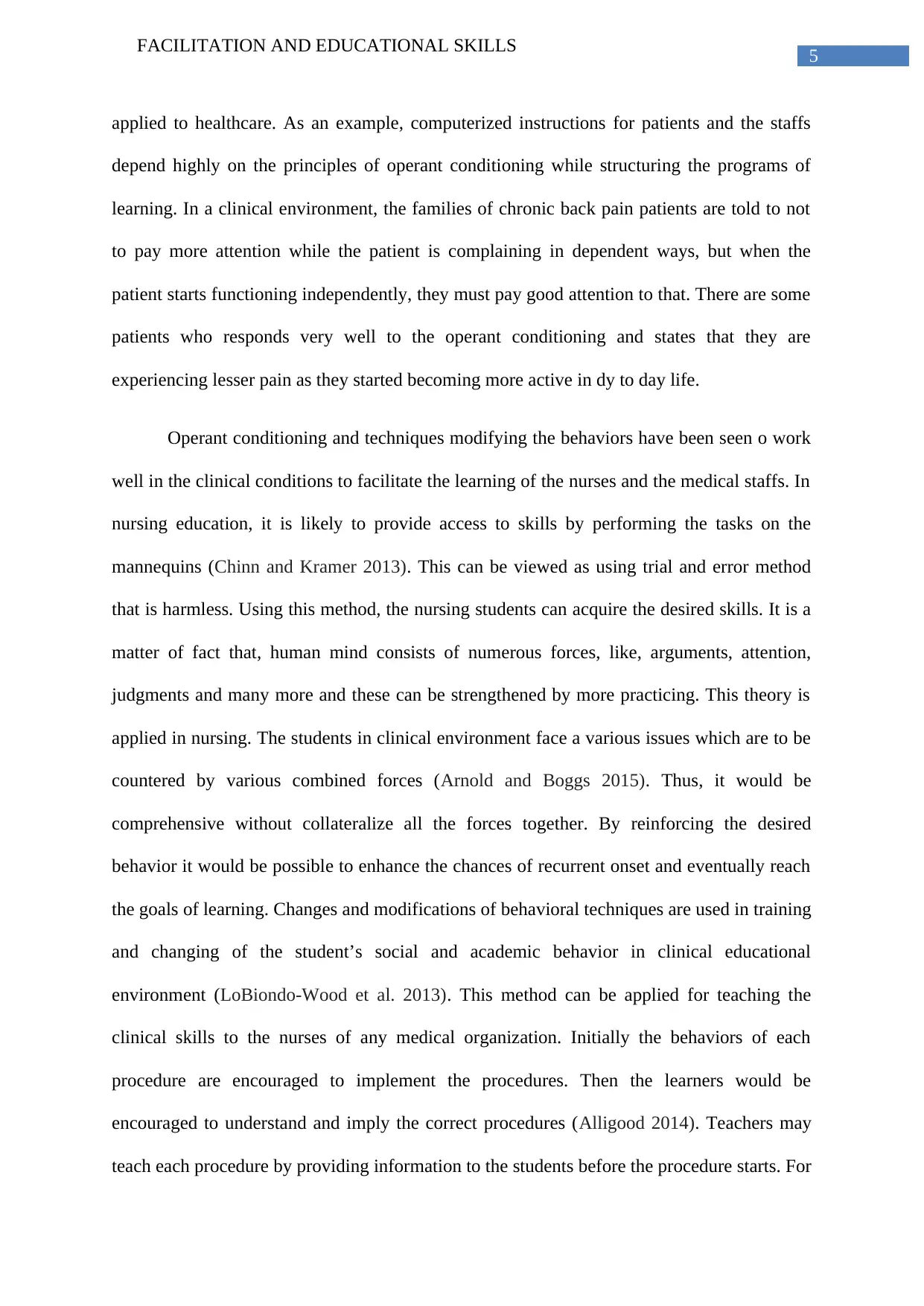
5
FACILITATION AND EDUCATIONAL SKILLS
applied to healthcare. As an example, computerized instructions for patients and the staffs
depend highly on the principles of operant conditioning while structuring the programs of
learning. In a clinical environment, the families of chronic back pain patients are told to not
to pay more attention while the patient is complaining in dependent ways, but when the
patient starts functioning independently, they must pay good attention to that. There are some
patients who responds very well to the operant conditioning and states that they are
experiencing lesser pain as they started becoming more active in dy to day life.
Operant conditioning and techniques modifying the behaviors have been seen o work
well in the clinical conditions to facilitate the learning of the nurses and the medical staffs. In
nursing education, it is likely to provide access to skills by performing the tasks on the
mannequins (Chinn and Kramer 2013). This can be viewed as using trial and error method
that is harmless. Using this method, the nursing students can acquire the desired skills. It is a
matter of fact that, human mind consists of numerous forces, like, arguments, attention,
judgments and many more and these can be strengthened by more practicing. This theory is
applied in nursing. The students in clinical environment face a various issues which are to be
countered by various combined forces (Arnold and Boggs 2015). Thus, it would be
comprehensive without collateralize all the forces together. By reinforcing the desired
behavior it would be possible to enhance the chances of recurrent onset and eventually reach
the goals of learning. Changes and modifications of behavioral techniques are used in training
and changing of the student’s social and academic behavior in clinical educational
environment (LoBiondo-Wood et al. 2013). This method can be applied for teaching the
clinical skills to the nurses of any medical organization. Initially the behaviors of each
procedure are encouraged to implement the procedures. Then the learners would be
encouraged to understand and imply the correct procedures (Alligood 2014). Teachers may
teach each procedure by providing information to the students before the procedure starts. For
FACILITATION AND EDUCATIONAL SKILLS
applied to healthcare. As an example, computerized instructions for patients and the staffs
depend highly on the principles of operant conditioning while structuring the programs of
learning. In a clinical environment, the families of chronic back pain patients are told to not
to pay more attention while the patient is complaining in dependent ways, but when the
patient starts functioning independently, they must pay good attention to that. There are some
patients who responds very well to the operant conditioning and states that they are
experiencing lesser pain as they started becoming more active in dy to day life.
Operant conditioning and techniques modifying the behaviors have been seen o work
well in the clinical conditions to facilitate the learning of the nurses and the medical staffs. In
nursing education, it is likely to provide access to skills by performing the tasks on the
mannequins (Chinn and Kramer 2013). This can be viewed as using trial and error method
that is harmless. Using this method, the nursing students can acquire the desired skills. It is a
matter of fact that, human mind consists of numerous forces, like, arguments, attention,
judgments and many more and these can be strengthened by more practicing. This theory is
applied in nursing. The students in clinical environment face a various issues which are to be
countered by various combined forces (Arnold and Boggs 2015). Thus, it would be
comprehensive without collateralize all the forces together. By reinforcing the desired
behavior it would be possible to enhance the chances of recurrent onset and eventually reach
the goals of learning. Changes and modifications of behavioral techniques are used in training
and changing of the student’s social and academic behavior in clinical educational
environment (LoBiondo-Wood et al. 2013). This method can be applied for teaching the
clinical skills to the nurses of any medical organization. Initially the behaviors of each
procedure are encouraged to implement the procedures. Then the learners would be
encouraged to understand and imply the correct procedures (Alligood 2014). Teachers may
teach each procedure by providing information to the students before the procedure starts. For
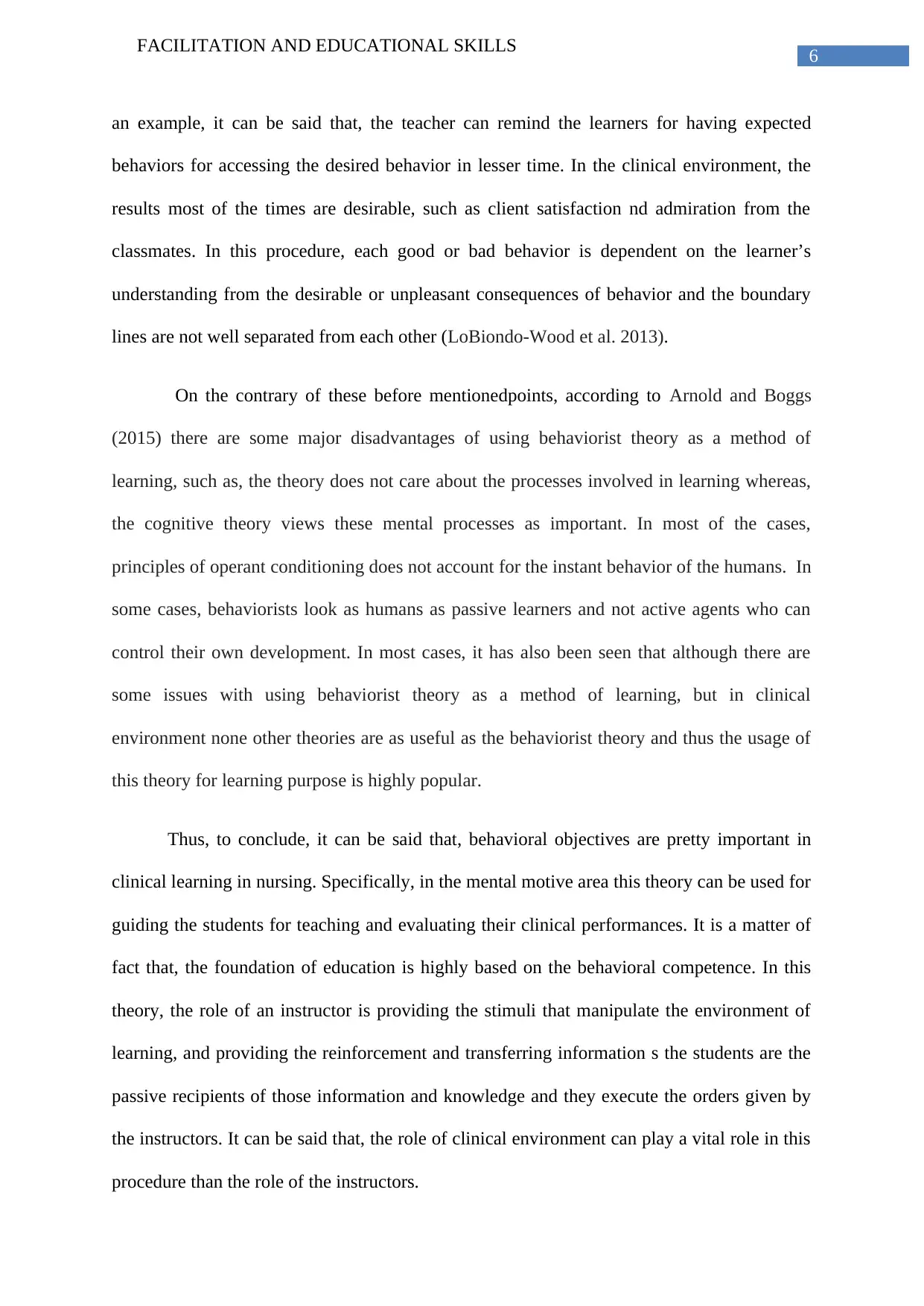
6
FACILITATION AND EDUCATIONAL SKILLS
an example, it can be said that, the teacher can remind the learners for having expected
behaviors for accessing the desired behavior in lesser time. In the clinical environment, the
results most of the times are desirable, such as client satisfaction nd admiration from the
classmates. In this procedure, each good or bad behavior is dependent on the learner’s
understanding from the desirable or unpleasant consequences of behavior and the boundary
lines are not well separated from each other (LoBiondo-Wood et al. 2013).
On the contrary of these before mentionedpoints, according to Arnold and Boggs
(2015) there are some major disadvantages of using behaviorist theory as a method of
learning, such as, the theory does not care about the processes involved in learning whereas,
the cognitive theory views these mental processes as important. In most of the cases,
principles of operant conditioning does not account for the instant behavior of the humans. In
some cases, behaviorists look as humans as passive learners and not active agents who can
control their own development. In most cases, it has also been seen that although there are
some issues with using behaviorist theory as a method of learning, but in clinical
environment none other theories are as useful as the behaviorist theory and thus the usage of
this theory for learning purpose is highly popular.
Thus, to conclude, it can be said that, behavioral objectives are pretty important in
clinical learning in nursing. Specifically, in the mental motive area this theory can be used for
guiding the students for teaching and evaluating their clinical performances. It is a matter of
fact that, the foundation of education is highly based on the behavioral competence. In this
theory, the role of an instructor is providing the stimuli that manipulate the environment of
learning, and providing the reinforcement and transferring information s the students are the
passive recipients of those information and knowledge and they execute the orders given by
the instructors. It can be said that, the role of clinical environment can play a vital role in this
procedure than the role of the instructors.
FACILITATION AND EDUCATIONAL SKILLS
an example, it can be said that, the teacher can remind the learners for having expected
behaviors for accessing the desired behavior in lesser time. In the clinical environment, the
results most of the times are desirable, such as client satisfaction nd admiration from the
classmates. In this procedure, each good or bad behavior is dependent on the learner’s
understanding from the desirable or unpleasant consequences of behavior and the boundary
lines are not well separated from each other (LoBiondo-Wood et al. 2013).
On the contrary of these before mentionedpoints, according to Arnold and Boggs
(2015) there are some major disadvantages of using behaviorist theory as a method of
learning, such as, the theory does not care about the processes involved in learning whereas,
the cognitive theory views these mental processes as important. In most of the cases,
principles of operant conditioning does not account for the instant behavior of the humans. In
some cases, behaviorists look as humans as passive learners and not active agents who can
control their own development. In most cases, it has also been seen that although there are
some issues with using behaviorist theory as a method of learning, but in clinical
environment none other theories are as useful as the behaviorist theory and thus the usage of
this theory for learning purpose is highly popular.
Thus, to conclude, it can be said that, behavioral objectives are pretty important in
clinical learning in nursing. Specifically, in the mental motive area this theory can be used for
guiding the students for teaching and evaluating their clinical performances. It is a matter of
fact that, the foundation of education is highly based on the behavioral competence. In this
theory, the role of an instructor is providing the stimuli that manipulate the environment of
learning, and providing the reinforcement and transferring information s the students are the
passive recipients of those information and knowledge and they execute the orders given by
the instructors. It can be said that, the role of clinical environment can play a vital role in this
procedure than the role of the instructors.
Paraphrase This Document
Need a fresh take? Get an instant paraphrase of this document with our AI Paraphraser
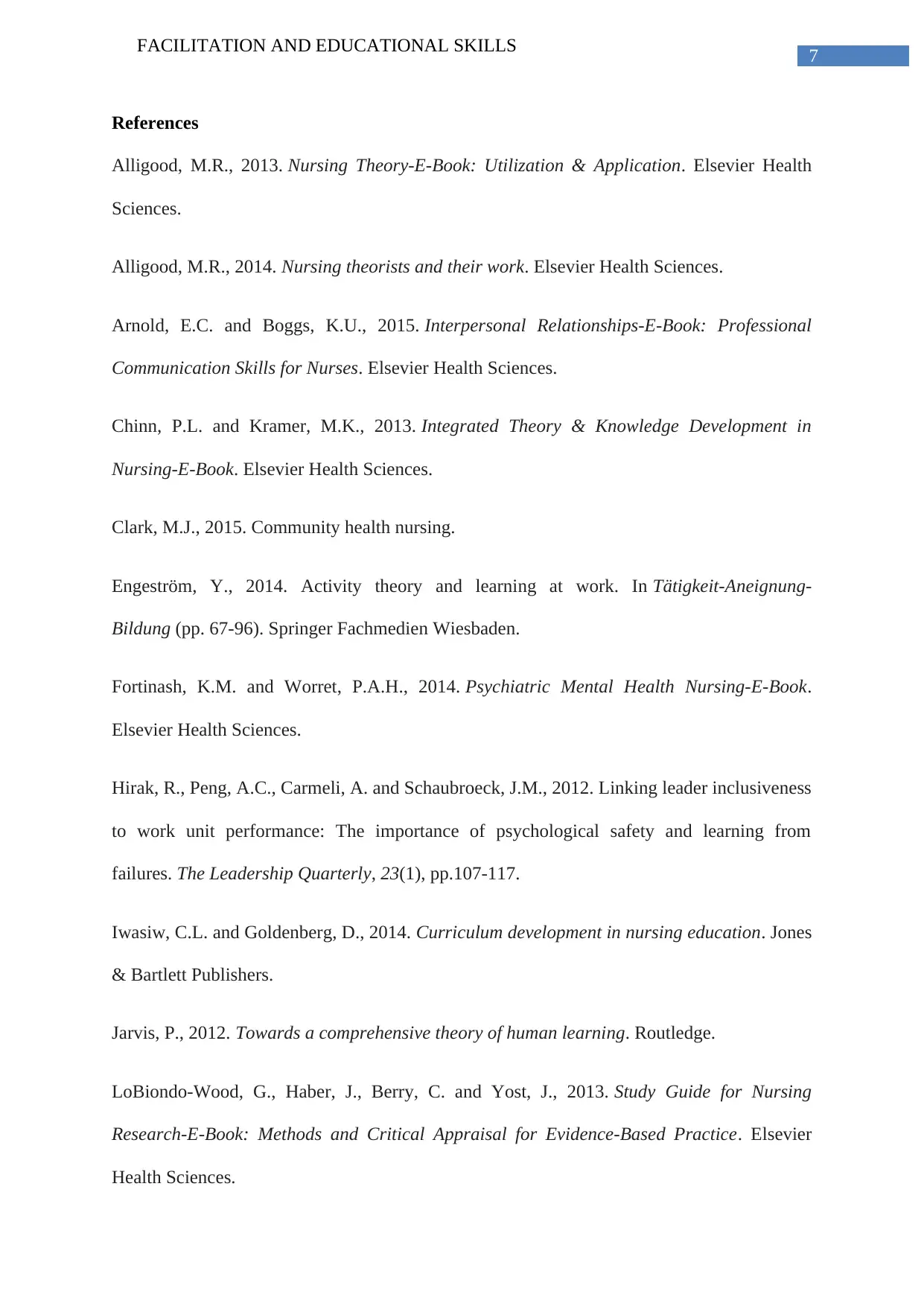
7
FACILITATION AND EDUCATIONAL SKILLS
References
Alligood, M.R., 2013. Nursing Theory-E-Book: Utilization & Application. Elsevier Health
Sciences.
Alligood, M.R., 2014. Nursing theorists and their work. Elsevier Health Sciences.
Arnold, E.C. and Boggs, K.U., 2015. Interpersonal Relationships-E-Book: Professional
Communication Skills for Nurses. Elsevier Health Sciences.
Chinn, P.L. and Kramer, M.K., 2013. Integrated Theory & Knowledge Development in
Nursing-E-Book. Elsevier Health Sciences.
Clark, M.J., 2015. Community health nursing.
Engeström, Y., 2014. Activity theory and learning at work. In Tätigkeit-Aneignung-
Bildung (pp. 67-96). Springer Fachmedien Wiesbaden.
Fortinash, K.M. and Worret, P.A.H., 2014. Psychiatric Mental Health Nursing-E-Book.
Elsevier Health Sciences.
Hirak, R., Peng, A.C., Carmeli, A. and Schaubroeck, J.M., 2012. Linking leader inclusiveness
to work unit performance: The importance of psychological safety and learning from
failures. The Leadership Quarterly, 23(1), pp.107-117.
Iwasiw, C.L. and Goldenberg, D., 2014. Curriculum development in nursing education. Jones
& Bartlett Publishers.
Jarvis, P., 2012. Towards a comprehensive theory of human learning. Routledge.
LoBiondo-Wood, G., Haber, J., Berry, C. and Yost, J., 2013. Study Guide for Nursing
Research-E-Book: Methods and Critical Appraisal for Evidence-Based Practice. Elsevier
Health Sciences.
FACILITATION AND EDUCATIONAL SKILLS
References
Alligood, M.R., 2013. Nursing Theory-E-Book: Utilization & Application. Elsevier Health
Sciences.
Alligood, M.R., 2014. Nursing theorists and their work. Elsevier Health Sciences.
Arnold, E.C. and Boggs, K.U., 2015. Interpersonal Relationships-E-Book: Professional
Communication Skills for Nurses. Elsevier Health Sciences.
Chinn, P.L. and Kramer, M.K., 2013. Integrated Theory & Knowledge Development in
Nursing-E-Book. Elsevier Health Sciences.
Clark, M.J., 2015. Community health nursing.
Engeström, Y., 2014. Activity theory and learning at work. In Tätigkeit-Aneignung-
Bildung (pp. 67-96). Springer Fachmedien Wiesbaden.
Fortinash, K.M. and Worret, P.A.H., 2014. Psychiatric Mental Health Nursing-E-Book.
Elsevier Health Sciences.
Hirak, R., Peng, A.C., Carmeli, A. and Schaubroeck, J.M., 2012. Linking leader inclusiveness
to work unit performance: The importance of psychological safety and learning from
failures. The Leadership Quarterly, 23(1), pp.107-117.
Iwasiw, C.L. and Goldenberg, D., 2014. Curriculum development in nursing education. Jones
& Bartlett Publishers.
Jarvis, P., 2012. Towards a comprehensive theory of human learning. Routledge.
LoBiondo-Wood, G., Haber, J., Berry, C. and Yost, J., 2013. Study Guide for Nursing
Research-E-Book: Methods and Critical Appraisal for Evidence-Based Practice. Elsevier
Health Sciences.
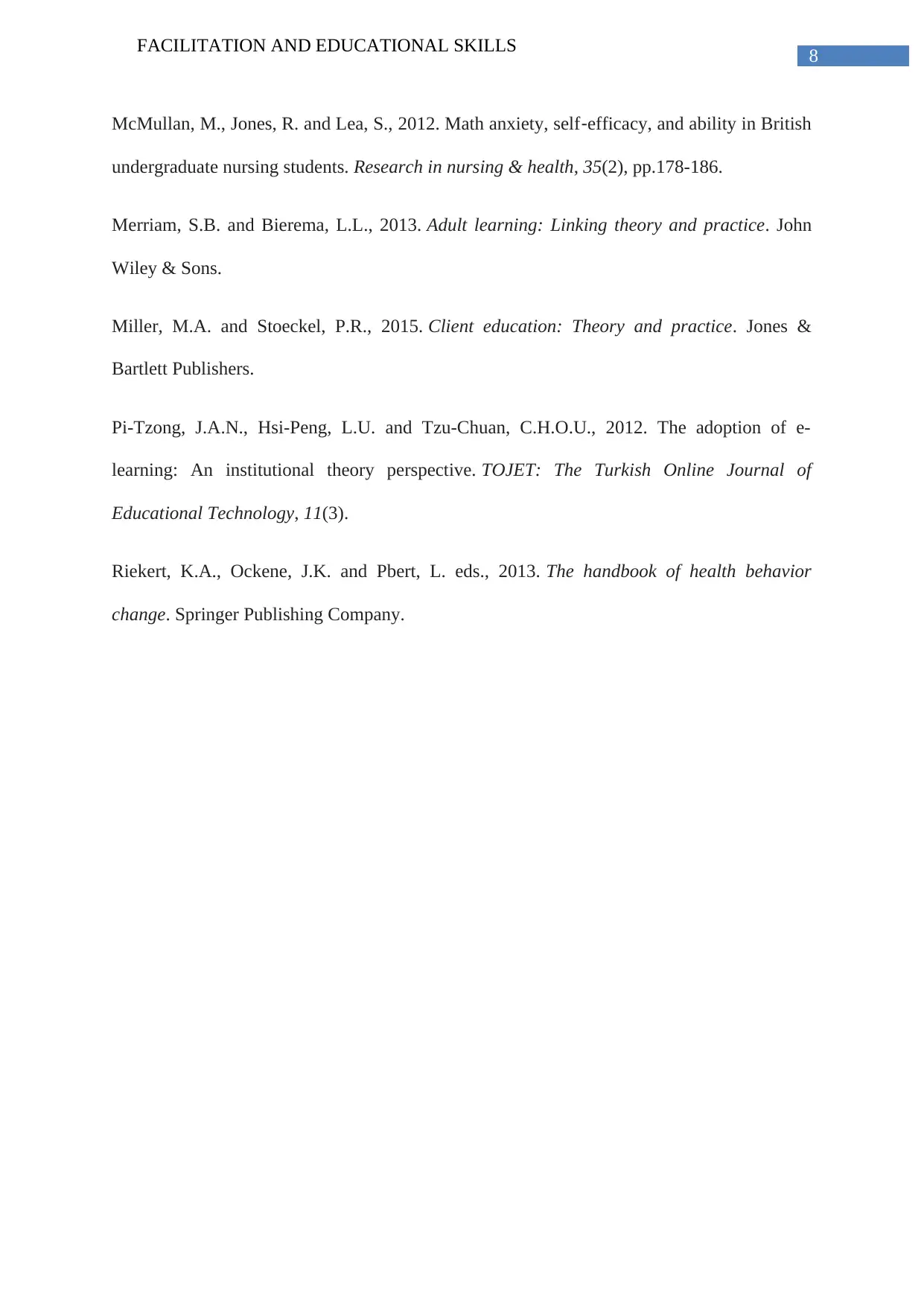
8
FACILITATION AND EDUCATIONAL SKILLS
McMullan, M., Jones, R. and Lea, S., 2012. Math anxiety, self‐efficacy, and ability in British
undergraduate nursing students. Research in nursing & health, 35(2), pp.178-186.
Merriam, S.B. and Bierema, L.L., 2013. Adult learning: Linking theory and practice. John
Wiley & Sons.
Miller, M.A. and Stoeckel, P.R., 2015. Client education: Theory and practice. Jones &
Bartlett Publishers.
Pi-Tzong, J.A.N., Hsi-Peng, L.U. and Tzu-Chuan, C.H.O.U., 2012. The adoption of e-
learning: An institutional theory perspective. TOJET: The Turkish Online Journal of
Educational Technology, 11(3).
Riekert, K.A., Ockene, J.K. and Pbert, L. eds., 2013. The handbook of health behavior
change. Springer Publishing Company.
FACILITATION AND EDUCATIONAL SKILLS
McMullan, M., Jones, R. and Lea, S., 2012. Math anxiety, self‐efficacy, and ability in British
undergraduate nursing students. Research in nursing & health, 35(2), pp.178-186.
Merriam, S.B. and Bierema, L.L., 2013. Adult learning: Linking theory and practice. John
Wiley & Sons.
Miller, M.A. and Stoeckel, P.R., 2015. Client education: Theory and practice. Jones &
Bartlett Publishers.
Pi-Tzong, J.A.N., Hsi-Peng, L.U. and Tzu-Chuan, C.H.O.U., 2012. The adoption of e-
learning: An institutional theory perspective. TOJET: The Turkish Online Journal of
Educational Technology, 11(3).
Riekert, K.A., Ockene, J.K. and Pbert, L. eds., 2013. The handbook of health behavior
change. Springer Publishing Company.
1 out of 9
Your All-in-One AI-Powered Toolkit for Academic Success.
+13062052269
info@desklib.com
Available 24*7 on WhatsApp / Email
![[object Object]](/_next/static/media/star-bottom.7253800d.svg)
Unlock your academic potential
© 2024 | Zucol Services PVT LTD | All rights reserved.





